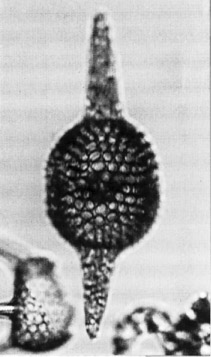 Didymocyrtis
prismatica (Haeckel)
Didymocyrtis
prismatica (Haeckel) Didymocyrtis
prismatica (Haeckel)
Didymocyrtis
prismatica (Haeckel)Pipettella prismatica Haeckel, 1887, p.305, pl.39, fig.6; Riedel, 1959, p.287, pl.1, fig.1
Pipettella tuba Haeckel, 1887, p.337, pl.39, fig.7
Cannartus prismaticus (Haeckel), Riedel and Sanfilippo, 1970, pl.15, fig.1
Didymocyrtis prismatica (Haeckel), Sanfilippo and Riedel, 1980, p.1010
Cortical shell ellipsoidal, with the major axis generally 1.1-1.2 times the length of the minor axis, and with the wall somewhat thicker at the equatorial band than at the poles. Pores of the cortical shell circular, regularly arranged and usually hexagonally framed, ten to fifteen on the half-equator, separated by rather narrow intervening bars. Surface of the cortical shell slightly rough. Medullary shell almost invariably present, spherical or slightly lenticularly compressed, thin-walled and with subcircular pores, joined to the cortical shell by an equatorial series of [supporting bars]. Subcylindrical spongy polar columns arise rather abruptly from the cortical shell, and have meshes much smaller than those of the cortical shell. In some specimens the meshes of the polar columns are longitudinally aligned, and four to six longitudinal ridges extend along their surface (Riedel, 1959).
Based on 30 specimens. Major axis of cortical shell 115-163 µm, minor axis 108-148 µm. Diameter of medullary shell 28-38 µm. Length of polar columns 50-240 µm; median breadth 12-35 µm (Riedel, 1959).
Length of cortical shell 115-175 µm, its maximum breadth 105-150 µm (Sanfilippo et al., 1985).
Didymocyrtis prismatica similar to D. tubaria and D. violina and other Didymocyrtis species of the upper Oligocene to lowermost Miocene, but with the absence of any equatorial constriction, or plicae evident on the cortical shell. Similar also to other unnamed Didymocyrtis species, especially in subtropical to subpolar latitudes, but with spongy polar columns that are only up to one quarter the width of the cortical shell (Moore, pers. comm., 1992).
Didymocyrtis prismatica differs from D. tubaria by the equator of the cortical shell not being puckered (Sanfilippo et al., 1985).
The ellipsoidal cortical shell with a narrow spongy column at each pole is usually thick-walled, rarely thinned by dissolution. Presence of a single or double medullary shell is characteristic of the genus Didymocyrtis, but many specimens of D. prismatica show no trace of it, nor of its supporting bars. It is not yet clear whether this is a result of dissolution of a very delicate structure (Sanfilippo et al., 1985).
This species occurs in substantial numbers in assemblages of late Oligocene to early Miocene age in all oceans, including the Mediterranean region. Its morphotypic first appearance lies within the Theocyrtis tuberosa Zone and its morphotypic last appearance lies within the Calocycletta costata Zone.
This species developed from Lithocyclia angusta by reduction of the number of spongy arms from three to two, and by the axis of rotational symmetry becoming aligned with the spongy columns, rather than being at right angles to their plane. Didymocyrtis prismatica apparently gave rise to D. tubaria and to D(?) bassanii (Carnevale) (Sanfilippo et al., 1973, p.216, pl.l, figs.1-3): it accompanies both of these species through a major part of their stratigraphic ranges (Sanfilippo et al., 1985).
Additional illustrations can be found in Riedel and Sanfilippo, 1971, pl.2C, figs.11-13, pl.4, fig.5; Moore, 1971, pl.12, figs.1-2; Sanfilippo et al., 1973, pl.1, fig.8.
See Holdsworth (1975) for a discussion of the development of the medullary shell.